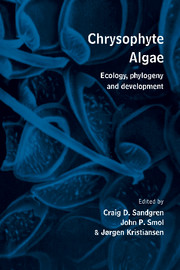Book contents
- Frontmatter
- Contents
- Preface
- List of contributors
- 1 History of chrysophyte research: origin and development of concepts and ideas
- Part I Phylogeny, systematics and evolution
- 2 Evolution of plastid genomes: inferences from discordant molecular phylogenies
- 3 A modern concept of chrysophyte classification
- 4 Current status of chrysophyte ‘splinter groups’: synurophytes, pedinellids, silicoflagellates
- Part II Development, physiology and nutrition
- Part III Ecology, paleoecology and reproduction
- Part IV Contributed original papers
- Index of scientific names
- Subject index
3 - A modern concept of chrysophyte classification
Published online by Cambridge University Press: 05 March 2012
- Frontmatter
- Contents
- Preface
- List of contributors
- 1 History of chrysophyte research: origin and development of concepts and ideas
- Part I Phylogeny, systematics and evolution
- 2 Evolution of plastid genomes: inferences from discordant molecular phylogenies
- 3 A modern concept of chrysophyte classification
- 4 Current status of chrysophyte ‘splinter groups’: synurophytes, pedinellids, silicoflagellates
- Part II Development, physiology and nutrition
- Part III Ecology, paleoecology and reproduction
- Part IV Contributed original papers
- Index of scientific names
- Subject index
Summary
Previous concepts of classification
Until recently, most concepts of higher taxa in the Chrysophyceae have been based on some combination of vegetative morphological features and characteristics of the motile cells (such as flagellar number and position). For a survey on the various systematic treatments of the Chrysophyceae by earlier workers (Pascher 1914; Fritsch 1935; Bourrelly 1968; Fott 1971; Bold & Wynne 1978; Christensen 1980; Ettl 1980; and Kristiansen 1982) the reader is referred to Round (1986). In the present account (see Tables 3.1–3.3) special reference is given only to the more recent treatments by Starmach (1985) and Kristiansen (1986, 1990).
Within the class Chrysophyceae, Starmach (1985) distinguished three subclasses: the Heterochrysophycidae, the Acontochrysophycidae and the Craspedomonadophycidae. The Craspedomonadophycidae of Starmach included the choanoflagellates (families Monosigaceae and Salpingoecaceae) and the genus Phalansterium (family Phalansteriaceae) which are now known from electron microscopic studies to have no structural similarities with any group of algae (Hibberd 1986), and it is now generally accepted that they should be classified only as Protozoa. Starmach's scheme more or less followed that of Bourrelly (1968, 1981), in which three different lineages were recognized: the uniflagellate order Chromulinales in the subclass Heterochrysophycidae, the biflagellate order Ochromonadales in the subclass Heterochrysophycidae, and several aflagellate orders in the subclass Acontochrysophycidae.
- Type
- Chapter
- Information
- Chrysophyte AlgaeEcology, Phylogeny and Development, pp. 46 - 74Publisher: Cambridge University PressPrint publication year: 1995
- 21
- Cited by

